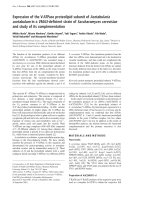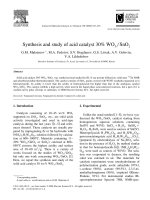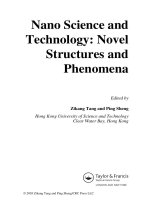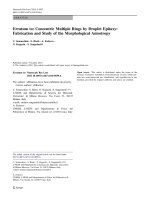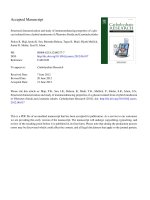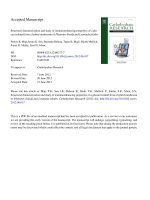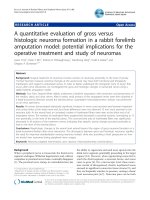Novel metal-free and metallophthalocyanines containing four 21-membered pentathiadiaza macrocycles: synthesis, characterization, and study of aggregation properties
Bạn đang xem bản rút gọn của tài liệu. Xem và tải ngay bản đầy đủ của tài liệu tại đây (529.57 KB, 10 trang )
Turkish Journal of Chemistry
/>
Research Article
Turk J Chem
(2014) 38: 1073 – 1082
ă ITAK
c TUB
doi:10.3906/kim-1403-63
Novel metal-free and metallophthalocyanines containing four 21-membered
pentathiadiaza macrocycles: synthesis, characterization, and study of aggregation
properties
ă , Berna FARSAK, Hă
Halil Zeki GOK
ulya KELES
¸ , Mustafa KELES
¸
Department of Chemistry, Faculty of Arts and Sciences, Osmaniye Korkut Ata University, Osmaniye, Turkey
Received: 24.03.2014
•
Accepted: 17.06.2014
•
Published Online: 24.11.2014
•
Printed: 22.12.2014
Abstract: Metal-free phthalocyanine 3 and its metallophthalocyanine derivatives 4, 5, and 6 (M = Zn, Co, and Ni) substituted with four 21-membered pentathiadiaza macrocycles were synthesized and their structures identified by elemental
analysis, IR,
1
H NMR, mass, and UV-Vis spectroscopy techniques. The aggregation properties of phthalocyanines 4, 5,
and 6 were investigated in different solvents and at different concentrations of dimethylformamide.
Key words: Macrocycle, aggregation, metal-free phthalocyanine, metallophthalocyanine
1. Introduction
The number of studies in the field of synthesis of phthalocyanines has been increasing since the first accidental
synthesis of phthalocyanine in the early 1930s. Because most of the synthesized phthalocyanines exhibit
chemical and thermal stability, 1,2 they have been used in different technologies and medical applications, such
as photosensitizers in photodynamic therapy, 3,4 biomedicine, catalysis, electronics, 5,6 gas sensors, 7,8 optical
data storage, 9 corrosion inhibitors, 10 and electrochromic displays. 11
For phthalocyanines, the potential applications depend on their solubilities in common organic solvents
and water. Their low solubilities in organic solvents restrict the investigation of their chemical and physical
characteristics and also limit the capabilities of these compounds in a wide range of commercial applications.
A goal of research into phthalocyanine chemistry is to enhance the solubilities of phthalocyanines in various
solvents. For this purpose, the attachment of solubility-enhancing groups, such as bulky groups, 12 glycerols, 13
long alkyl chains, 14 and macrocycles, 15 to phthalocyanines can improve their solubility properties in common
solvents.
Incorporation of a macrocycle into the phthalocyanine skeleton affects their optical and electrochemical properties. 16 The cavity of the macrocycle is hydrophilic, whereas the exterior flexible framework is
hydrophobic. 17 The selectivity of the macrocycle towards the metal ion is dependent on the cavity size, the type
of donor atom of the macrocycle, and the type and size of the metal ion. The type of donor atoms in the macrocycle causes different structural conformations. The presence of oxygen donor atoms in macrocycles results
in an endocyclic conformation, whereas the sulfur containing macrocycles are mostly exocyclic. 18 Macrocycles
that contain sulfur atoms as donor atoms show unusual coordinating behavior and have high abilities to form
complexes with some transition metal ions. 19 The synthesis of macrocycles with sulfur donor atoms and their
∗ Correspondence:
1073
¨ et al./Turk J Chem
GOK
attachment to the phthalocyanine skeleton is rare in the literature due to the laborious and time-consuming
synthetic procedure and toxic chemicals. 20
In this study, we report the synthesis, characterization, and study of aggregation properties of metal-free
and metallophthalocyanines bearing four 21-membered macrocycles with nitrogen and sulfur donor atoms.
2. Results and discussion
2.1. Synthesis and characterization
The synthetic route for the target metal-free 3 and metallophthalocyanines 4, 5, and 6 is shown in Figure 1.
Characterization of the newly synthesized compounds was performed by elemental analysis and spectroscopic
techniques. N,N’-(2,2’-(4,5-dicyano-1,2-phenylene)bis(sulfanediyl)bis(2,1-phenylene))bis(2-chloroacetamide) 1
was synthesized by following the procedure reported in the literature. 21
Generally, the synthesis of a macrocycle requires high dilution techniques or the template effect. The
macrocyclization reaction was performed by adding a solution of 1 in dry dimethylformamide to a stirring
solution of dithiol in dry dimethylformamide containing anhydrous sodium carbonate as the base at 0–5 ◦ C.
Final purification by silica gel chromatography afforded the macrocycle 6,16-dioxo-5,6,7,9,10,12,13,15,16,17decahydrotribenzo[k, n, q][1,4,7,13,16,10,19]pentathiadiazacyclohenicosine-24,25-dicarbonitrile 2 in 49% yield.
The remarkable yield of the macrocyclization reaction without using a high dilution technique can be attributed to the probable hydrogen bonding between the amide oxygen atoms of the bis(α -chloroamide) and the
amine hydrogen atoms of the bis-secondary amines in starting compound 1 and the template effect of sodium
cations. 22,23
The IR spectrum of macrocyclic compound 2 indicated an intense C ≡N stretching band at 2234 cm −1 ,
a NH stretching band at 3285 cm −1 , and a sharp C=O vibration band at 1682 cm −1. The 1 H NMR spectrum
of 2 was collected in CDCl 3 . The appearance of a new resonance for the SCH 2 protons at δ = 2.83 ppm
as a multiplet in the 1 H NMR spectrum of 2 confirmed the formation of macrocyclization. The 13 C NMR
spectrum of 2 also supports this interpretation; new signals appear at 38.12 ppm for O=CCH 2 S and at 34.57
and 32.42 ppm for the SCH 2 carbons, and the spectrum is consistent with the proposed formulation. The
resonance belonging to the C=O group was observed at δ = 166.84 ppm in the
observation of the molecular ion peak at m/z = 608.88 [M + H]
in good agreement with the proposed structure.
+
13
C NMR spectrum of 2. The
in the LC–MS/MS mass spectra of 2 is also
The cyclotetramerization of the phthalonitrile derivative 2 afforded the metal-free phthalocyanine 3. In
the
1
H NMR spectrum of 3, the inner core protons of metal-free phthalocyanine 3 was observed at δ = –
3.36 ppm as a broad signal. 24 The other protons belonging to the macrocycle and phthalocyanine skeleton were
barely observed in the 1 H NMR spectrum of 3. The C ≡ N stretching vibration at 2234 cm −1 in the IR spectrum
of starting compound 2 was not observed in the IR spectrum of 3. This also suggested the cyclotetramerization
of 2 to 3. The elemental analysis result of 3 is consistent with calculated values for 3. The LC–MS/MS mass
spectrum of 3 contained a molecular ion peak at m/z = 2435 [M + H] + .
The metallophthalocyanines 4, 5, and 6 were obtained from the dicyano derivative 2 and the corresponding anhydrous metal salts, Zn(CH 3 CO 2 )2 , Co(CH 3 CO 2 )2 , and NiCl 2 respectively. The NH group in
the macrocycle gave a stretching vibration band at 3272, 3275, and 3296 cm −1 in the IR spectra of metallophthalocyanines 4, 5, and 6, respectively. The strong C ≡N stretching vibration of 2 was not observed in the IR
spectra of metallophthalocyanines 4, 5, and 6, which can be regarded as clear evidence for the formation of
1074
¨ et al./Turk J Chem
GOK
Figure 1. The synthesis of the metal-free phthalocyanine and metallophthalocyanines.
phthalocyanines. The obtained IR spectra of the metallophthalocyanines 4, 5, and 6 are very similar due to
the structure similarity, except for the metal ions in the phthalocyanine core. The 1 H NMR spectrum of metallophthalocyanines 4 and 6 indicated similar signals for the macrocycle and phthalocyanine skeleton with small
shifts in ppm. The planar phthalocyanine structure has a tendency for aggregation due to the relatively high
concentration used for the NMR measurements, 25,26 and caused the broad signals in the 1 H NMR spectrum of
metal-free phthalocyanine 3 and metallophthalocyanines 4 and 6. The signals that occurred in the 1 H NMR
spectra of metallophthalocyanines 4 and 6 are in agreement with the proposed structure for those compounds.
In the mass spectra of 4, 5, and 6, the presence of molecular ion peaks at m/z = 2497 [M + H] + , 2492 [M +
H] + , and 2491 [M + H] + (Figure 2 for compound 5), respectively, confirmed the proposed structures.
1075
¨ et al./Turk J Chem
GOK
Figure 2. MALDI-TOF mass spectrum of cobalt(II) phthalocyanine 5.
2.2. Absorption and aggregation properties
The spectroscopic studies of phthalocyanines in the UV-Vis region indicate 2 strong absorptions maxima; one is
in the UV region at 300–500 nm known as the B band. The more intense and energetic absorption, known as the
Q band, lies near 600–700 nm. 27,28 The UV-Vis absorption spectrum of metal-free phthalocyanine 3 in DMF
and THF is shown in Figure 3. The split in the Q band is a characteristic for phthalocyanine molecules with
the D 2h symmetry point group such as metal-free phthalocyanine. The resolution of the split in the Q band
decreases as wavelength increases 29,30 and in the presence of aggregated phthalocyanine species in solution. 31,32
The UV-Vis absorption spectrum of 3 in DMF indicated the Q band at 733 nm without splitting. An unsplit Q
band is probably due to the polarity of DMF used for recording UV-Vis absorption spectra for 3. 33 The UV-Vis
spectra of the metal-free phthalocyanine 3 in less polar solvent such as THF (Figure 3) showed an indistinct Q
band with an absorption max at 741 nm and a shoulder at 714 nm. The Soret or B band for 3 was observed in
the near UV region at λmax = 327 and 367 nm. This transition is ascribed to the deeper π – π * levels of the
LUMO transitions. 34
0.3
Absorbance
dimethylformamide
tetrahydrofuran
0.2
0.1
0
300
400
500
600
700
800
900
Wavelength (nm)
Figure 3. UV-Vis spectra of the metal-free phthalocyanine 3 in DMF and THF (concentration = 4 × 10 −6 mol/L).
1076
¨ et al./Turk J Chem
GOK
The UV-Vis absorption spectra of the synthesized metallophthalocyanines 4, 5, and 6 in DMF are shown
in Figure 4. The position of the Q bands of the phthalocyanine core with metal ions 4, 5, and 6 indicated
a slight shift to the higher energy side in comparison with the parent metal-free phthalocyanine 3. In the
UV-Vis absorption spectra of 4, 5, and 6, intense Q band absorptions were observed at 713, 695, and 708 nm,
respectively, while the B band absorptions were observed at 376, 335, and 321 nm, respectively. In general, the
substituted and unsubstituted phthalocyanine core with metal ions belonging to D 4h symmetry shows only an
intense Q band absorption in their UV-Vis spectra. 35
0.8
ZnPc (4)
CoPc (5)
NiPc (6)
Absorbance
0.6
0.4
0.2
0.0
300
400
500
600
700
800
Wavelength (nm)
Figure 4. UV-Vis spectra of metallophthalocyanines 4, 5, and 6 in DMF.
Metallophthalocyanines 4, 5, and 6 have the same macrocycle peripherally, but have different metal
ions. This similarity in molecular structure of those phthalocyanines resulted in similar shaped Q bands with
small shifts in the wavelength (Figure 4). 36 The Q band positions of metallophthalocyanines 4, 5, and 6 were
observed in the order of ZnPc > NiPc > CoPc.
The aggregation property of the phthalocyanines is usually examined by changing the concentration of
the studied phthalocyanine in solution or changing the solvent that is used for dissolving the phthalocyanine.
These changes affect the shape and position of the Q band if aggregation occurs. Due to the presence of dimers
and higher-order complexes of phthalocyanines, a broadening of the Q band and/or a splitting of the Q band
in the UV-Vis absorption spectrum can be observed. 37
In the present study, the aggregation properties of the phthalocyanine complexes 4, 5, and 6 changing with
increased concentration were examined by using DMF and THF in the 5 × 10 −5 –2 × 10 −6 mol/L concentration
range. The effect of changing concentration on the aggregation properties of metallophthalocyanines 4, 5, and
6 can be seen in Figures 5a and 5b for ZnPc, Figures 6a and 6b for CoPc, and Figures 7a and 7b for NiPc. The
metallophthalocyanines 4–6 did not aggregate in solution at the concentrations between 10 × 10 −6 and 1 ×
10 −6 mol/L.
In conclusion, metal-free phthalocyanine 3 and metallophthalocyanines 4–6 bearing four 21-membered
macrocycles were synthesized and characterized by several spectroscopic techniques. The aggregation properties
of the synthesized phthalocyanines 4–6 were investigated in different solvents at different concentrations. The
Beer–Lambert law was obeyed for metallophthalocyanines 4–6 for the concentrations between 10 × 10 −6 and
1 × 10 −6 mol/L.
1077
¨ et al./Turk J Chem
GOK
ZnPc (4) in THF
a)
3
366 nm
Absorbance
2.5
637 nm
709 nm
2
1.5
1
0.5
0
0.0E+00
2.0E-05
4.0E-05
6.0E-05
Concentration (M)
ZnPc (4) in DMF
b)
1.6
376 nm
1.2
639 nm
Absorbance
713 nm
0.8
0.4
0
0.0E+00
2.0E-05
4.0E-05
6.0E-05
Concentration (M)
Figure 5. The aggregation properties of ZnPc (4) in (a) THF and (b) DMF at different concentrations: 5 × 10 −5 , 1.2
× 10 −5 , 1 × 10 −5 , 8 × 10 −6 , 6 × 10 −6 , 4 × 10 −6 , 2 × 10 −6 , 1 × 10 −6 mol/L.
CoPc (5) in THF
a)
4
Absorbance
3
335 nm
627 nm
692 nm
2
1
0
0.0E+00
2.0E-05
4.0E-05
Concentration (M)
6.0E-05
CoPc (5) in DMF
b)
4
335 nm
629 nm
Absorbance
3
695 nm
2
1
0
0.0E+00
2.0E-05
4.0E-05
Concentration (M)
6.0E-05
Figure 6. The aggregation properties of CoPc (5) in (a) THF and (b) DMF at different concentrations: 5 × 10 −5 , 1.2
× 10 −5 , 1 × 10 −5 , 8 × 10 −6 , 6 × 10 −6 , 4 × 10 −6 , 2 × 10 −6 , 1 × 10 −6 mol/L.
1078
¨ et al./Turk J Chem
GOK
a)
NiPc (6) in THF
3
414 nm
Absorbance
630 nm
2
706 nm
1
0
0.0E+00
2.0E-05
4.0E-05
6.0E-05
Concentration (M)
b)
NiPc (6) in DMF
3
Absorbance
415 nm
2
635 nm
707 nm
1
0
0.0E+00
2.0E-05
4.0E-05
6.0E-05
Concentration (M)
Figure 7. The aggregation properties of NiPc (6) in (a) THF and (b) DMF at different concentrations: 5 × 10 −5 , 1.2
× 10 −5 , 1 × 10 −5 , 8 × 10 −6 , 6 × 10 −6 , 4 × 10 −6 , 2 × 10 −6 , 1 × 10 −6 mol/L.
3. Experimental
3.1. Materials
The starting phthalonitrile containing N-chloroacetamide 1 was prepared by following the route described in the
literature. 21 All reagents and solvents were reagent grade quality and were obtained from commercial suppliers.
All solvents were dried and purified as described by Armerago and Chai. 38
3.2. Equipment
FTIR spectra were measured on a PerkinElmer Spectrum 65 spectrometer in KBr pellets. 1 H and 13 C NMR
spectra were recorded on a Varian Mercury 400 MHz spectrometer in CDCl 3 and DMSO-d 6 (99.9%). Mass
spectra were measured on a Micromass Quatro LC/ULTIMA LC–MS/MS and a Bruker Daltonics MALDI-TOF
spectrometer. Optical spectra were recorded in the UV-Vis region with a PG T80 + spectrophotometer in 1-cm
path length cuvettes at room temperature. The elemental analyses were obtained with a LECO Elemental Analyzer (CHNS 0932) spectrophotometer. The melting points were determined with an electrothermal apparatus
and are reported without correction.
1079
¨ et al./Turk J Chem
GOK
3.3. Synthesis
3.3.1. 6,16-Dioxo-5,6,7,9,10,12,13,15,16,17-decahydrotribenzo[k, n, q][1,4,7,13,16,10,19]penta
thiadiazacyclohenicosine-24,25-dicarbonitrile (2)
2,2 ′ -Thiodiethanedithiol (0.585 g, 3.8 mmol) was placed in dry dimethylformamide containing anhydrous sodium
carbonate (1.61 g, 15.18 mmol) under inert gas. Then the mixture was put in an ice bath and cooled to 0–5 ◦ C.
Compound 1 (2 g, 3.8 mmol) was dissolved in 250 mL of dry dimethylformamide and added dropwise over 1.5 h
to the stirring reaction mixture. The proceeding of the reaction was followed by thin layer chromatography with
hexane:ethyl acetate (6:4). After a total of 24 h of stirring, the reaction was complete. The mixture was filtered
to remove the inorganic salts and the filtrate was evaporated to dryness. The yellowish residue was redissolved
in CH 2 Cl 2 , and washed with a 5% Na 2 CO 3 solution and water, consecutively. The combined organic extracts
were dried over anhydrous Na 2 SO 4 , and evaporated to dryness to give a crude product. This crude product
was further purified by chromatography over a silica gel column using hexane:ethyl acetate (6:4) as the solvent
system. The pure product was obtained as a white solid. The yield was 1.14 g (49%). mp: 204–205 ◦ C. Anal.
calcd for C 28 H 24 N 4 O 2 S 5 : C: 55.24; H: 3.97; N: 9.20%. Found: C: 54.93; H: 4.14; N: 8.84. IR (KBr disk)
νmax /cm −1 : 3285 (NH), 3051 (CH Ar ), 2923 (CH 3 ), 2234 (C ≡N), 1682 (C=O), 1577, 1565, 1513, 1433, 1345,
1295, 1197, 1032, 917, 764, 659, 526.
1
H NMR (CDCl 3 ) ( δ : ppm): 9.81 (s, 2H, NH), 8.57 (d, J = 8.3 Hz 2H,
ArH), 7.65 (t, J = 7.8 Hz 2H, ArH), 7.54 (d, J = 7.8 Hz 2H, ArH), 7.32 (t, J = 7.5 Hz 2H, ArH), 7.04 (s, 2H,
ArH), 3.50 (s, 4H, O=CCH 2 Cl), 2.83 (m, 8H, SCH 2 ) . 13 C NMR (CDCl 3 ) ( δ : ppm): 166.84 (C=O), 142.98,
140.07, 136.28, 132.75, 130.84, 126.40, 122.07, 117.75 (ArC), 114.82 (C≡N), 113.14 (ArC), 38.12 (O=CCH 2 S),
34.57, 32.42 (SCH 2 ). MS (LC–MS/MS) m/z: 608.88 [M + H] + .
3.3.2. Metal-free phthalocyanine (3)
A mixture of 2 (0.4 g, 0.657 mmol) and dry n -pentanol (1.5 mL) was placed in a standard Schlenk tube
containing a few drops of 1,8-diazabicyclo[5.4.0]undec-7-ene (DBU) and stirred under nitrogen at 145 ◦ C for 24
h. After cooling to room temperature, the reaction mixture was poured into ethanol (10 mL). The precipitate
was filtered. The crude product was placed in a Soxhlet extractor and refluxed with ethanol (25 mL) for 4 h,
followed by washing with diethyl ether and was dried under vacuum. The yield was 0.090 g (22.5%). mp >
300
◦
C. Anal. calcd. for C 112 H 98 N 16 O 8 S 20 : C: 55.19; H: 4.05; N: 9.19%. Found: C: 54.85; H: 3.84; N: 9.14.
IR (KBr disk) νmax /cm −1 : 3381 (NH), 3285 (NH), 3055 (CH Ar ) , 2918 (CH 3 ) , 1660 (C=O), 1603, 1574, 1508,
1473, 1437, 1378, 1301, 1259, 1105, 1021, 872, 741, 677.
1
H NMR (DMSO-d 6 ) ( δ : ppm): 9.96 (br, s, 8H, NH),
9.00 (m, 8H, ArH), 7.59–6.85 (m, 32H, ArH), 3.58 (br, s, 16H, O=C-CH 2 ) , 2.76 (m, 32H, SCH 2 ) , –3.36 (br, s,
2H, NH). UV-Vis (DMF): λmax , nm (log ε): 733 (4.71), 367 (4.98), 327 (5.02). MS (LC–MS/MS) m/z: 2435.00
[M + H] + (C 112 H 99 N 16 O 8 S +
20 ; calc: 2435.22)
3.3.3. Zinc(II) phthalocyanine (4)
A mixture of 2 (0.3 g, 0.493 mmol), anhydrous Zn(CH 3 CO 2 )2 (0.027 g, 0.151 mmol), and quinoline (2 mL)
was placed in a Schlenk tube and stirred at 190 ◦ C for 7 h under nitrogen. The mixture was cooled to room
temperature, followed by addition of ethanol (10 mL) to precipitate the crude product. The crude product was
placed in a Soxhlet extractor and refluxed with ethanol (25 mL) for 4 h. The green product was then filtered and
washed with ethyl acetate, acetone, and diethyl ether. Finally, silica gel column chromatography of the crude
1080
¨ et al./Turk J Chem
GOK
product with the solvent system of dichloromethane:methanol afforded pure zinc(II) phthalocyanine in 0.067 g
(22%), which was dried under vacuum over P 2 O 5 . mp = 257–258 ◦ C. Anal. calcd. for C 112 H 96 N 16 O 8 S 20 Zn:
C: 53.79; H: 3.87; N: 8.96%. Found: C: 53.32; H: 4.22; N: 8.48. IR (KBr disk) νmax /cm −1 : 3272 (NH), 3055
(CH Ar ), 2908 (CH 3 ), 1679 (C=O), 1576, 1510, 1433, 1298, 1112, 1063, 938, 754.
1
H NMR (DMSO-d 6 ) : ( δ :
ppm): 10.13 (br, s, 8H, NH), 8.72 (m, 8H, ArH), 7.98–6.89 (m, 32H, ArH), 3.51 (br, s, 16H, O=C–CH 2 ) , 2.84–
2.74 (m, 32H, SCH 2 ). UV-Vis (DMF): λmax , nm (log ε) : 713 (4.94), 639 (4.33), 376 (4.82). MS (MALDI-TOF)
m/z: 2497.27 [M + H] + (C 112 H 97 N 16 O 8 S 20 Zn + ; calc: 2497.13).
3.3.4. Cobalt(II) phthalocyanine (5)
Cobalt(II) phthalocyanine was obtained after following the same procedure in 3.3.3. Anhydrous Co(CH 3 CO 2 )2
(0.026 g, 0.151 mmol) was used instead of Zn(CH 3 CO 2 )2 .
The yield was 0.190 g (63%). mp > 300 ◦ C. Anal. calcd. for C 112 H 96 N 16 O 8 S 20 Co: C: 53.93; H: 3.88;
N: 8.98%. Found: C: 53.30; H: 4.14; N: 8.27. IR (KBr disk) νmax /cm −1 : 3275 (NH), 3051 (CH Ar ), 2914 (CH 3 ),
1681 (C=O), 1578, 1514, 1435, 1408, 1298, 1119, 959, 755. UV-Vis (DMF): λmax , nm (log ε) : 695 (4.98), 634
(4.58), 335 (5.05). MS (MALDI-TOF) m/z: 2492.01 [M + H] + , 2514.18 [M + Na] + (C 112 H 97 N 16 O 8 S 20 Co + ;
calc: 2492.14).
3.3.5. Nickel(II) phthalocyanine (6)
Nickel(II) phthalocyanine was obtained after following the same procedure in 3.3.3. Anhydrous NiCl 2 (0.019 g,
0.151 mmol) was used instead of Zn(CH 3 CO 2 )2 .
The yield was 0.147 g (49%). mp > 300
◦
C. Anal. calcd. for C 112 H 96 N 16 O 8 S 20 Ni: C: 53.94; H:
3.88; N: 8.99%. Found: C: 54.09; H: 4.27; N: 8.85. IR (KBr disk) νmax /cm −1 : 3296 (NH), 3058 (CH Ar ), 2911
(CH 3 ), 1682 (C=O), 1578, 1514, 1435, 1411, 1380, 1298, 1121, 962, 754.
1
H NMR (DMSO-d 6 ) ( δ : ppm): 10.10
(br, s, 8H, NH), 8.63 (m, 8H, ArH), 7.59–7.35 (m, 32H, ArH), 3.47 (br, s, 16H, O=C–CH 2 ) , 2.84 (br, s, 32H,
SCH 2 ). UV-Vis (DMF): λmax , nm (log ε): 708 (5.10), 635 (4.51), 414 (4.43), 321 (4.94). MS (MALDI-TOF)
m/z: 2491.64 [M + H] + (C 112 H 97 N 16 O 8 S 20 Ni + ; calc: 2491.14).
Acknowledgments
ă ITAK)
Financial support from the Scientific and Technological Research Council of Turkey (TUB
(Project No:
ă (Department of Chemistry,
TBAG-109T806) is gratefully acknowledged. We are also grateful to Dr Ya¸sar GOK
Osmaniye Korkut Ata University) for her valuable help in evaluating the NMR data.
References
1. Leznoff, C. C.; Lever, A. B. P. Phthalocyanines: Properties and Applications, vol. 4, VCH Publishers: New York,
NY, USA, 1996.
2. Piechocki, C.; Simon, J.; Skoulios, A.; Guillon, D.; Weber, P. J. Am. Chem. Soc. 1982, 104, 5245–5247.
3. Master, A. M.; Rodriguez, M. E.; Kenney, M. E.; Oleinick, N. L.; Gupta, A. S. J. Pharm. Sci. 2010, 99, 2386–2398.
4. Peng, Y.; Lin Z.; Huang, J.; Chen, N. Dyes Pigm. 2005, 67, 145–151.
5. Bouvet, M. In The Porphyrin Handbook: Applications of Phthalocyanines; Kadish, K. M.; Smith, K. M.; Guilard,
R. Eds. Elsevier: San Diego, CA, USA, 2003, pp. 37–98.
1081
¨ et al./Turk J Chem
GOK
6. Flom, S. R. In The Porphyrin Handbook: Applications of Phthalocyanines; Kadish, K. M.; Smith, K. M.; Guilard,
R. Eds. Elsevier: San Diego, CA, USA, 2003, pp. 179–189.
7. Parra, V.; Bouvet, M.; Brunet, J.; Rodr´ıguez-M´endez, M. L.; de Saja J. A. Thin Solid Films 2008, 516, 9012–9019.
8. Fleischer, M.; Simon, E.; Rumpel, E.; Ulmer, H.; Harbeck, M.; Wandel, M.; Fietzek, C.; Weimar, U.; Meixner, H.
Sens. Actuators B 2002, 83, 245–249.
9. Luo, Q.; Tian, H.; Chen, B.; Huang, W. Dyes Pigm. 2007, 73, 118–120.
10. Zhao, P.; Liang, Q.; Li, Y. Appl. Surf. Sci. 2005, 252, 1596–1607.
11. Mortimer, R. J.; Dyer, A. L.; Reynolds, J. R. Displays 2006, 27, 2–18.
12. Un, I.; Zorlu, Y.; Ibisoglu, H.; Dumoulin, F.; Ahsen, V. Turk. J. Chem. 2013, 37, 394–404.
13. Bilgin, A.; Ertem, B.; Gă
ok, Y. Polyhedron 2005, 24, 11171124.
14. Liu, H.; Liu, Y.; Liu, M.; Chen. C.; Xi, F. Tetrahedron Lett. 2001, 42, 7083–7086.
15. Kılı¸caslan, M. B.; Kantekin, H. Turk. J. Chem. 2014, 38, 317327.
16. Basova, T. V.; Jushina, I. V.; Gă
urek, A. G.; Atilla, D.; Ahsen, V. Dyes Pigm. 2009, 80, 6772.
Gă
17. Kantekin, H.; De
girmencio
glu, I.;
ok, Y. Acta Chemica Scandinavica 1999, 53, 247–252.
18. Wolf, R. E.; Hartman, J. R.; Storey, J. M. E.; Foxman, B. M.; Cooper, S. R. J. Am. Chem. Soc. 1987, 109,
43294335.
ă Kantekin, H.; Alp, H. Transition Met. Chem. 2007, 32, 10731078.
19. Gă
ok H. Z.; Ocak, U.;
20. Ozoemena, K.; Nyokong, T. Electrochim. Acta 2002, 47, 40354043.
21. Gă
ok, H. Z.; Farsak, B. J. Organomet. Chem. 2013, 735, 65–71.
22. Bradshaw, J. S.; Krakowiak, K. E.; Izatt, R. M. J. Heterocycl. Chem. 1989, 26, 1431–1435.
23. Yang, Z.; Bradshaw, J. S.; Zhang, X. X.; Savage, P. B.; Krakowiak, K. E.; Dalley, N. K.; Su, N.; Todd Bronson,
R.; Izatt, R. M. J. Org. Chem. 1999, 64, 31623170.
ă Bayrak, R.; Piáskin, M.; Akácay, H. T.; Durmu¸s, M.; Kantekin, H. J. Organomet. Chem. 2012, 724,
24. Demirbaás, U.;
22252234.
ă Synth. Met. 2005, 155, 211221.
25. Să
ulă
u, M.; Altındal, A.; Bekaro˘
glu, O.
26. Van Nostrum, C. F.; Picken, S. J.; Schouten, A. J.; Nolte, R. J. J. Am. Chem. Soc. 1995, 117, 9957–9765.
27. Whalley, M. J. Chem. Soc. 1961, 866–869.
28. Choi, M.; Li, P. P.; Ng, D. K. Tetrahedron 2000, 56, 3881–3887.
29. Kobayashi, N.; Ogata, H.; Nonaka, N.; Luk’yanets, E. A. Chem.-A Eur. J. 2003, 9, 5123–5134.
30. Ogunbayo, T. B.; Nyokong, T. Polyhedron 2009, 28, 2710–2718.
31. Van Nostrum, C. F.; Picken, S. J.; Nolte, R. J. Angew. Chem., Int. Ed. 1994, 33, 2173–2175.
32. Leznoff, C. C.; Suchozak, B. Can. J. Chem. 2001, 79, 878–887.
33. Yanık, H.; Aydın, D.; Durmu¸s, M.; Ahsen, V. J. Photochem. Photobiol., A. 2009, 206, 18–26.
34. Bilgin, A.; Ertem, B.; Gă
ok, Y. Eur. J. Inorg. Chem. 2007, 12, 1703–1712.
35. Takahashi, K.; Kawashima, M.; Tomita, Y.; Itoh, M. Inorg. Chim. Acta 1995, 232, 69–73.
36. Tian, M.; Wada, T.; Sasabe, H. J. Heterocycl. Chem. 2000, 37, 1193–1202.
37. Engelkamp, H.; Nolte, R. J. M. J. Porphyrins. Phthalocyanines 2000, 4, 454–459.
38. Armarego, W. L.; Chai, C. L. L. Purification of Laboratory Chemicals: Elsevier: Oxford, UK, 2003.
1082
